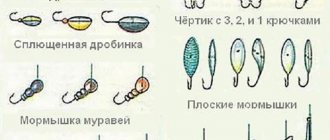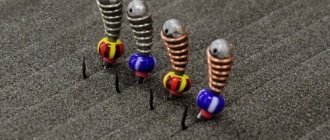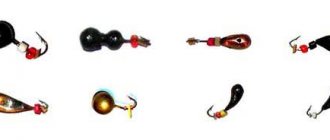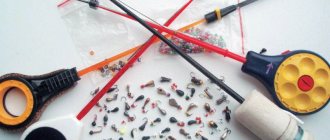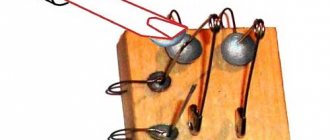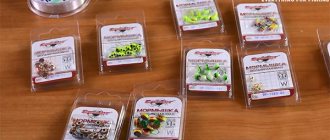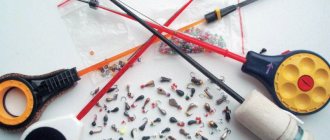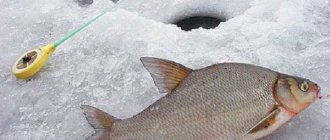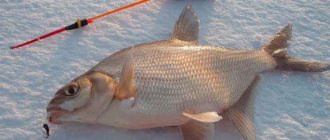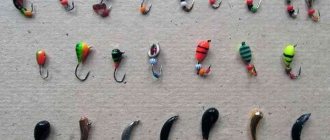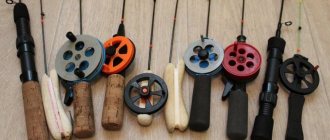DIY tungsten jigs
Tungsten jigs occupy a special place in the arsenal of a winter fishing enthusiast. Due to the high density of this metal, they have significant mass with small sizes. When fishing at great depths and in strong currents, tungsten jigs are unrivaled. And, despite the wide selection of gear in specialized stores, avid fishermen prefer to use homemade products. Tungsten is a very refractory metal, and casting methods applicable to tin and lead are not suitable in this case. So serial manufacturers resort to all sorts of tricks, selling, under the guise of tungsten, jigs sintered from powder, which, in addition to the main component, includes various low-melting additives, and this significantly reduces the specific gravity of the product. You can get a jig from pure tungsten only by turning it from a blank. Therefore, let’s look at how you can make tungsten jigs with your own hands.
Making the jig itself
First of all, the question arises: where can I get tungsten wire with a diameter of 3–4 mm? The easiest way is to turn to any welder who works with argon welding for help. During his work, he always ends up with small pieces of electrodes that are quite suitable for making jigs. Now you can start cutting. You will need a grinder and abrasive wheels. It is better to fix the grinder, then it will be more convenient to work with both hands.
A simple jig can be made using a drill and file. To do this, the electrode is inserted into the drill chuck and the workpiece is processed with a file.
Hook groove
Sometimes grooves for a hook and holes for a fishing line are made in the workpiece, but it should be understood that any groove or hole reduces the specific gravity of the jig, so they should be minimal.
Now that the body of the jig is ready, you need to take care to solder the hook to it. Alas, ordinary soldering will not work in this case. In order for the tin to adhere to the tungsten, the body of the jig must be coated with brass or copper. To do this, you can use an acetylene torch, or assemble a simple device for electroplating. You will need: a constant voltage source, for example, a phone charger, a resistor, copper sulfate, copper wire.
The copper wire should be twisted into a spiral, placed in a glass with a saturated solution of vitriol (with sediment) and connected to the positive pole. The jig is connected to the negative through a resistor and lowered into the glass using a crocodile holder.
Electroplating tool
The resistor resistance is derived from the formula R=U/I. U is the voltage that the power supply produces, I is the required current strength, equal to 0.04 A. Thus, for 8-volt “charging” you need a 200 Ohm resistor, for 12-volt – 300 Ohms, etc. The copper plating process lasts about half an hour.
After copper plating, the body of the jig needs to be tinned with solder, after which you can solder the hook, which is first bent to the shape of the body of the jig. The finished jig can be painted with nitro paint in several layers.
Sometimes, instead of soldering, the hook to the body is fixed with epoxy resin. The reliability of such a connection will depend on the quality of the glue.
Using copper wire
If making tungsten jigs at home using the method described above seems complicated to you, then you can resort to some tricks. For example, secure the hook with thin copper wire. The hook is bent at the desired angle, joined to the body with a small amount of glue, and then tightly wrapped with copper wire.
Clean with a soldering iron and file
This method is applicable for large jigs. When making small ones, the weight loss is significant.
Perhaps the easiest way to make a tungsten jig at home is to attach it to a piece of tungsten electrode using a cambric. After heating over a flame, the insulation shrinks, securely fixing the workpiece and hook.
Characteristics of winter jigs
Conditions for fishing in winter differ significantly from summer fishing. Their assortment in summer is much more diverse, but in winter the most attractive is the jig.
Winter jigs are small in size. They are painted so that the fish can see from afar. They are also supplied with different attachments.
Tungsten jigs are more popular in this market, since they are made from this material and have greater weight and small dimensions. They are suitable for certain fishing conditions involving deep water and fast currents.
Lures with bait are considered a classic method of winter fishing. Bait is attached to them, for example, bloodworms. It works well when the fish doesn't want to bite. They can be purchased at any fishing tackle store. But you can do it yourself.
There are two types of such jigs:
- “pellet” is a widely used bait for winter fishing. Made in a round shape, has different color shades. Suitable for fishing for perch, roach;
- "a drop". In appearance it resembles a pellet, but has an elongated shape. Very effective for fast retrieves when the game has its own form. This game attracts perch.
Lures are catchy when the fish are active, then they don’t really pay attention to the quality of the food.
Nozzle-less jigs have their own modifications:
- “Uralka” is a classic, every fisherman must have it;
- “Devil” is a bait with three hooks. Used when fishing for pike perch;
- “goat” - looks like a devil, made of brass or copper. Has two hooks, suitable for catching any fish;
- “ant” - represents an ant in appearance, makes amplitude movements with the help of a fishing rod. this jig is used in winter for catching bream and roach;
- “Donkey” - looks like a coffee bean cut in half. It is black in color and has one hook.
Materials and shape
To make a jig of a new shape, it is necessary to make a matrix - the basis for pouring metal. Its material can be polystyrene or organic glass. Hardwood will also work.
Using a chisel, a recess is made in the selected material for the shape of the future product.
Lead is used in the manufacture of the boat. There is enough of it in any fisherman’s garage. A piece of lead must be melted over a gas burner in a frying pan. Use a spoon to remove all the slag during melting.
Then pour this molten lead into the prepared mold and let it cool. Next comes the processing of the workpiece with a file and abrasive materials.
Read Fishing for pike with vibrating tails and choosing bait
To make lead, you can also use suitable blanks from this material. Using a hammer, chisel, or metal scissors, we separate pieces of lead that are similar in size to a jig. Lead rods with a diameter of 3-4 mm are suitable for this.
Size, weight and color
This bait is a product made of different metals, has a unique shape and has different artificial and natural baits on the hook. The choice of jig depends on the fishing location and the type of fish.
They are all divided into:
- light - weight from 0.3 g. They are all kinds of pieces and plates of metal and have a more delicate playing;
- heavy - made of lead and tin. They are suitable for fishing in severe frost, when the hole quickly becomes covered with ice. The heavy bait quickly sinks to the bottom and is not carried away by the current;
- super heavy - usually made of heavy metals. They are used for very weak bites.
Having high sensitivity, the fish hears even very faint sounds in the water. She is attracted by the nature and shape of the bait, which is similar to the food item.
An experienced fisherman constantly monitors the work of the bait. For example, many bites occur at the time when it begins to come off the bottom.
Fish can notice a small piece of metal even in the dark. It is believed that perch loves brass, roach - silver and black. And bream prefers red and black.
When choosing a jig by color, you need to remember how it plays in the water. Each bait of each weight, color and shape should have its own game.
Jig hook
The placement of the hook matters. An incorrectly soldered hook will interfere with proper play and does not guarantee a reliable hook.
It is better to use a single-flex hook - the tip in such a hook is located in the same plane as the fore-end.
The most catchy ones come from the hands of the fisherman, only forged hooks must be used. They are stronger than circle hooks.
Perhaps color plays a role in jigs without attachments. The tip must be very sharp; the hooking force, and therefore the thickness of the fishing line, depends on this.
Tula Tungsten Mormyshka
Many people know that the city of Tula is a city of heroes, a city of gunsmiths. Tula gingerbread and Tula samovar are the calling card of the city of Tula. But so far, few people know that Tula is also the birthplace of the tungsten turned jig - the “Tula tungsten jig.” Even today, Tula craftsmen never cease to amaze us with their discoveries and products. So they made a great gift for the fisherman - a tungsten jig of the highest class.
“TULSKAYA JORMYSHKA” jigs are in great demand among amateur fishermen and sports fishermen participating in international jig fishing competitions, and this is well deserved.
Many fishermen know first-hand the benefits of tungsten jigs. They differ in shape, color, price, but at the same time, the lack of information about the material density of certain products makes it difficult for the buyer to choose.
The main difference between a tungsten jig and a lead jig is its high density (i.e., higher specific gravity). Tungsten jigs found in stores can be divided into three classes:
1. Tungsten. groove jig.
It is made from tungsten blanks VNZH, VND with a density of 18 g/cm. The appropriate shape is given by turning or grinding. Next, a groove is cut, which subsequently, when attaching the hook, is filled with solder to form a hole for the fishing line.
The density of the tungsten jig is significantly reduced by cutting a groove in the tungsten workpiece. The loss of the specific gravity of the jig directly depends on the size of the groove, its length and width.
The technology for making such jigs is complex and labor-intensive, so they are not widely used.
2. Tungsten. pressed jigs.
Recently, stores have been filled with tungsten jigs produced by pressing.
It would be a stretch to call them tungsten. Pure tungsten only comes in powder form. To give the alloy a certain shape, various binding additives are used: copper, nickel, iron. These elements bind the grains of tungsten powder, giving it the necessary strength and density. Tungsten billets are produced by powder metallurgy. Special equipment is required for pressing, high-temperature hydrogen furnaces for subsequent complex heat treatment - sintering.
This can only be done by specialized powder metallurgy enterprises, of which there are only a few in Russia.
Pressed tungsten jigs sold at retail are usually made at home using lead, glue or something similar as a binding element. Since they are very fragile, to give mechanical strength they are coated with molten tin or some other substance. The density of such jigs is 14 g/cm, which is slightly higher than the density of lead analogues.
There are jigs in which copper and nickel are used as binders. These jigs or turning blanks have great strength. But the lack of special equipment does not allow obtaining a density of such jigs higher than 15 g/cm3.
3. And, finally, tungsten jigs, turned with cambric and a flat, known to a wide range of anglers as “Tula jigs”.
This jig is sharpened from a tungsten billet obtained at a specialized enterprise. The density of the workpiece exceeds 18.0 g/cm3. A hole is drilled in the product for the fishing line and hook. A cambric is inserted into the hole under the fishing line, which eliminates the rubbing of the fishing line on the metal and, as statistics show, increases the service life of the jig by 4-5 times. The soldering of the hook is carried out using specially designed equipment, the introduction of which eliminated failures in soldering, which sometimes lead to the hook falling out. The polished flat gives the jig a special game, which helps to increase the intensity of the bite.
A wide range of “Tula” jigs (drop, pellet, oatmeal, washer, devil, ant) and a large size range allow each angler to choose a jig according to the body of water and the fish.
Jigs for fishing
Mormysh is a small freshwater crustacean. This is where the name of the gear comes from. Tungsten-containing alloys are often used to make jigs. The choice of material is due to many reasons:
- Despite its small size, a tungsten jig has a lot of weight. Compared to lead, it is almost one and a half times heavier, and accordingly, it reaches the required depth faster.
- The miniature size of the tackle with a large weight makes it easier to “play”, while creating frequent vibrations, which attracts fish.
- Can be used for specific bodies of water.
- When made with your own hands, there is a field for the manifestation of imagination.
The only disadvantage of such gear is that it needs to create vibrations regularly, otherwise it will quickly stop. However, fishing in winter is a sport, so extra physical activity will not hurt the fisherman.
Varieties of forms
The shape of tungsten tackle depends on the body of water in which it will be used. This can be freshwater or sea fishing, in fast currents or in still water. The most popular include:
- Pellet. It is made in the form of a ball and is considered universal. More often used in large bodies of water.
- Droplet. A minimum of metal is used for production. Used when fishing for roach or bream.
- Ant. The tackle consists of two soldered pellets.
- Goat. Jig with two hooks.
- Banana. The shape resembles a maggot attached to a hook.
- Damn. With three hooks at the bottom. Good for vertical play. The forms can be varied.
- Cobra. The shape resembles the hood of a snake.
- A lot others.
The variety of shapes allows you to use jigs most effectively when catching any fish, with or without bait - on a bare hook.
Methods for making a homemade jig
Making jigs at home will not only provide you with consumables for winter fishing, but will also brighten up the long dark autumn evenings in anticipation of your favorite pastime. You can make baits for fishing with nod rods in various ways; in this review we will talk about the most popular of them.
Manufacturing methods
Before you decide how to make a jig, check that you have the necessary tools and materials to create the product using the chosen method. Each method allows you to make catchable bait if you approach this process creatively and with love.
Homemade tungsten jigs
When fishing in the summer and winter seasons, the use of gear differs significantly. Summer fishing is characterized by the use of a variety of baits. In the winter season, the choice of bait is small. Success in fishing largely depends on equipment. To ensure active biting, tungsten jigs are widely used.
Which jigs are the most catchy for winter fishing?
Mormyshka is an artificial bait used in winter due to the lack of natural bait. Tungsten is considered the best, as it has minimal dimensions and maximum possible weight. The specific gravity roughly corresponds to the weight of gold, one of the heaviest metals on earth. Homemade tungsten baits are used for fishing in fast currents and great depths.
Lures of this type have the following advantages:
- Stable behavior in fast currents and high degree of immersion.
- The bite improves, since the size of the bait corresponds to the small representatives of the underwater world that fish feed on in winter.
- High strength and durability thanks to tungsten material.
In turn, baits are divided into two types: moths and non-moths.
Under what conditions are they most effective?
The greatest effect from the use of tungsten jigs is obtained during winter fishing. In winter, the fish behaves passively, hunting for miniature underwater objects. This tackle is great for catching capricious and sluggishly biting fish.
In addition, tungsten jigs of the Diskus brand, manufactured by Diskus, weigh twice as much as lead, with small dimensions. This allows for effective fishing at great depths and fast currents.
Materials and tools
Making tungsten jigs with your own hands requires equipment with the appropriate materials and tools:
- tungsten electrode;
- fishing hook;
- plastic heat-shrinkable tube SSD;
- lighter;
- a grinding machine with a cutting disc for cutting the electrode;
- Super glue;
- protective glasses;
- bench vice;
- thin disk with diamond coating;
- set of files.
What to consider when making
It is necessary to take into account many nuances of the technological process. The problem is frequent line breakage due to the sharp edges of the tackle hole.
How to make a tungsten jig and avoid loss
To avoid unnecessary losses, they use a method such as inserting a plastic cambric into the hole of a tungsten jig.
In addition, it is necessary to avoid overheating when soldering the copper-plated layer of a tungsten bar to prevent peeling.
How to tie tungsten jigs correctly
Three categories of knots have been developed for how to properly tie a jig with an eye:
- Rigid tightening knots covering the ring with strong fixation. Recommended for use on thin lines.
- Loop knots that slide freely along the line loop are used on reelless gear.
- Hook knots, which are a compromise between loops and rigid knots. The strength is higher than on a loop, but lower than a rigid knot. Similar units are also used for attaching jigs without loops, with a hole.
What is the difference between tungsten and lead jigs?
This type of gear is superior to lead bait in physical characteristics, but is more expensive to purchase. Tungsten jigs can be easily made at home, just like lead jigs. Lead tackle differs from tungsten in that it is twice as large in size with the same weight.
Tungsten jig repair
The body of the tackle itself cannot be damaged, since the hardness is comparable to hardened steel. Repairing tungsten jigs involves replacing the broken hook and restoring the coating. It is possible to repair tungsten tackle by resoldering the hook shank.
Re-soldering tungsten jigs
When removing a broken hook, the galvanic coating may peel off, after which it is impossible to solder the hook to the jig with tin-lead solder. To solve the problem, you need to use hard solder consisting of an alloy of silver and copper. When soldering, use specialized fluxes, such as borax or boric acid.
How to make a “Devil” jig with your own hands
Jigs are very popular among anglers, especially in winter fishing for many types of fish. Fishermen are especially fond of the jig called “Devil”, which shows a high level of catchability. Many fishermen do not buy such a jig, but quite successfully make it themselves at home, and homemade products sometimes turn out much better than store-bought options.
Features of making jig "Devil"
To make your own “Devil” jig at home, you can use several different methods, among which are the following:
- — the process of manufacturing “Devil” without soldering or casting;
- — “Devil” using soldering;
- - production by casting method.
At the same time, the first method is the simplest and easiest, but it still allows you to get a very effective homemade “Devil” jig as a result; the other methods are somewhat more complicated.
Manufacturing without soldering or casting
In this case, you just need to mount a weight on the tee, finally secure it and paint it. Before doing this, you need to prepare the following set:
- — “Drop” sinkers made of silicone;
- - tee number 20 or slightly smaller, it should have a long fore-end and thin hooks;
- - beads or seed beads;
- — pliers and superglue;
- - file;
- — black waterproof varnish;
- - a drill or screwdriver with a thin drill bit, although this tool may not be needed.
We take the necessary sinker, remove it from the tube, while the ring of the tee must be carefully squeezed using pliers so that it can be inserted into the hole of the weight. You can also slightly widen the hole in the weight using a drill bit on a drill or screwdriver.
You should also put a bead or beads on the tee, a weight on top, then you should crimp the lead and fix it at the bottom with superglue. Then we process the workpiece with a file, paint it, and additionally hang beads or any other decorations. Cover with varnish.
Making “Devil” using soldering
The basis is a tee, and in order to make smaller versions of the jig, it is quite difficult to find small hooks for the tee, so you have to solder them yourself. At the same time, the preparation of such a tee is the basis for subsequent versions of the “Devil” manufacturing. In the future, you can use lead pouring or solder on top.
For soldering you will need the hooks themselves, some copper wire, a soldering iron and solder, you will also need either a plug or a drill to hold the hooks; if you need to hang a bead, you should prepare that too.
You should bite off the rings from a pair of hooks, while leaving the ring on the third one. The hooks should be tinned and then secured in the desired position - in the head of a drill or in a piece of cork, having made cuts in advance. Next, the workpiece is wrapped using pre-tinned wire and thoroughly soldered, then processed with a file.
Differences in bait shape
Jigs differ not only in weight, but also in shape. In order for the fish being fished to react to the bait as needed, the bait must imitate the behavior of a natural fish.
These must be the correct vibrations and vibrations that the predator feels from afar. It is for correct vibrations that the form must be special.
A flat jig, for example, plays well at the very bottom and picks up mud like small fish. Droplet jigs fall to the bottom and at the same time raise the turbidity in the form of a fountain.
Jigs called “barrel” or “little devil”, with any movement, immediately bury the hook deep into the silt and then sharply pull it out. Balls and drops are DIY reelless jigs.
Next, study the bait that the predator likes and, depending on the form of its behavior, decide what shape to make the bait
If you want to do everything correctly, then pay attention to the video on how to make a jig with your own hands.
How to make a jig at home
To prepare and replenish their arsenal of gear for winter fishing, anglers have to buy a large number of jigs. To put it simply, a jig is a consumable, it doesn’t last for a long time, and it’s terrible to fish as much as you want, so the purchase trips continue again. Losing a jig while fishing is commonplace. The fish breaks it off, just like the fisherman does with a sharp withdrawal, sometimes it gets untied due to unreliable fastening, and the jig hook also breaks. When you come to the store to buy a jig, you are sure to buy something else, it’s like a disease... Having a little time and desire, you can make most of the jigs, even from tungsten, yourself at home. I’m not bragging, but all my homemade jigs are of much better quality than similar store-bought ones. Otherwise, my friends wouldn’t pester me with constant requests to solder jigs for them.
At home, there is nothing difficult in making your own soldered eye-type jigs. If you calculate the time and money costs for making one soldered jig, they are very low. In one day it is quite possible to solder a hundred catchable and high-quality jigs for the entire winter fishing season.
To make a soldered jig you will need:
- A steel plate with drilled holes as an anvil, at least 10 mm thick (at your discretion, even a piece of rail will do);
- Balls from bearings with the diameters with which you want to make jigs, please note that the holes in the steel plate must have the same diameters as the balls;
- Electric soldering iron;
- Copper or brass foil;
- Fishing hooks;
- Tin, soldering acid, rosin;
- Emery cloth, file;
- Toothpicks;
- Pliers;
- Awl;
- Sewing needle;
- Potato tuber.
The procedure for making the eye jig
The principle of making a jig is to knock out a crown from copper or brass foil using a ball from a bearing. How to understand what diameter of the ball is needed to make an eye for a jig? To do this, you need to take a caliper and measure the diameter of any similar jig. This way you can choose as many different sizes of balls as you like, both larger and smaller in size from the jig that you measured. Selecting drills to match the diameters of the balls, we make holes in the steel plate. After drilling, remove the burrs.
The equipment is ready, the materials are prepared, we move on to making the jig.
We take copper or brass foil, place it on the drilled hole, and place a ball on top.
Using a hammer, lightly hit the ball.
The ball will press the hole into the foil, giving it its own diameter.
You will get this convex blank for the crown of the jig's eye.
Then we need to place the workpiece on a hole with a slightly smaller diameter, this will help to punch soft copper or brass evenly along the entire circumference by hitting a steel ball. To quickly separate the crown, it is necessary to strike with a hammer in the direction of the edge of the hole and so on along the entire diameter.
We get a convex mold of the future jig in which the hook will be mounted.
Using an awl, we punch a hole for the fishing line to pass through.
We insert a toothpick into the hole for convenience and grind the edges using sandpaper or a file to smooth them out.
We take a potato tuber with a shape that prevents rolling, for which you can trim the bottom part and make a hole on top.
We place a crown on a toothpick and stick it into the potato, so that the toothpick protrudes sufficiently into the hole of the crown.
We clean the hook for applying solder.
Take soldering acid.
Apply acid to the hook with a toothpick.
Apply soldering acid to the crown.
Using an electric soldering iron, apply a layer of molten tin to the hook (tinning).
We fix the hook with sticking on the tuber as follows.
We seal the hook in the hole of the crown with tin.
The hole sealed with tin along with the hook should look like this.
Take out the toothpick. We remove the remaining wood with a needle.
Use sandpaper to sand down the uneven surfaces and protruding edges of the tin. For shine, you can polish with GOI paste using felt.
Fishing methods
The jig is used in various fishing methods, and not only in winter.
- Classic game fishing with adding bloodworms.
- In the equipment of stationary winter fishing rods from the bottom.
- Summer fishing with a side nod or from a boat (you can also use winter gear).
- Winter baitless fishing (reelless).
- In installations of winter bottom gear (helicopter, locomotive, garland).
- To catch predators from ice, use large baits, weighing up to 100 grams.
This class of baits is transitional. Some predator jigs can hardly be called such, since their characteristics are closer to spinners. These are a variety of bullets and cones for pike perch, knockers for burbot and similar mormoblesses, crabs and others. A whitebait jig for perch is more of a micro-spoon than a standard understanding of the essence of this bait.
Mothless
Lately, baitless baits have emerged as a separate class of baits and fishing method. The principles of such fishing differ from fishing with bloodworms. The equipment, tactics, playing technique and the baits themselves are specific. With the help of a seductive game, the fish arouses curiosity rather than food interest.
